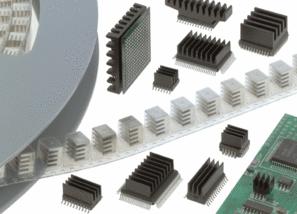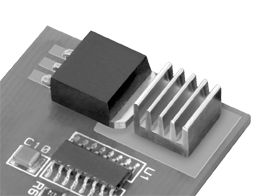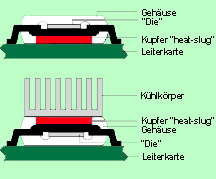
In the course of time there has been a constant change from IMT (Insert Mount Technology), i.e. the classical insertion mounting on PC boards to SMT (Surface Mount Technology), the surface mounting of the components on the PC board.
However, with the establishment of the SMD technology (SMD=Surface Mount Device) much has changed. These developments are apparent not only on the application side and with the automatic mounting machines, they also lead to concrete challenges for suitable solutions also in the area of heat reduction!
The integration density achieved so far, as well as the circuit functions, result in part in very large amounts of lost heat, which, with the small housing dimensions by all means represents a problem and requires great innovations and creativity for heat reduction.
Apart from the well known small signal and digital transistors, medium power transistors, the individual power losses of which amount to 0.5 to 1.2 watts, are now also available in SMD housings (e.g.: SOT89 etc.). However, power losses of 2 to 20 watts could be possible with suitable heat reduction, resulting in the use of these transistors as high voltage switches or power transistors. Even DC/DC converters would be possible – all in the SMD housing!
But there is now the difficulty that with high packing densities on the PC board, the large copper areas then required are not suitable for heat reduction and the SMD component advantage would be nullified.
Surely there are further methods of heat reduction, e.g. in the use of so-called metal core PC boards which, as the name indicates, contain an inner core of aluminium, for instance, through which the heat losses are then distributed and can be dissipated. But the high costs of this type of PC board are usually not justified. A further possibility to be considered would be selecting suitable SMD-IC in which the inner crystal, the "die", is placed by means of so-called copper heat-slug. These are heat-conducting copper inserts which steer the IC-internal heat transport to the PC board or away from the surface of the IC.

In the case of steering to the PC board, heat could be reduced by means of so-called thermal vias, small throughplatings which transport the heat through the PC board underneath the IC onto the opposite side of the PC board, for it to be dissipated there for instance on a larger copper surface or else a small heat sink.

In the case of the version of steering the heat losses to the surface of the component, the use of heat sinks is then very suitable, whereby a problem of IC technology, namely the diversification of the housing families, poses an additional challenge in the selection of suitable heat sinks.
RF power IC, analog IC with control systems and integrated power section, AD/DA and DC/DC converters, power operation amplifiers, motor drivers as well as the entire range of so-called Power SMD components require sufficient heat reduction by suitable measures.
The thermal resistance barrier layer to the surroundings (Rw J/A) depends very strongly upon the pin number of the IC, e.g. a P-QFP housing has lower values here than a P-DSO housing, whereby the calculation of the efficiency of the heat transport and the heat dissipation over the housing surface and the connections, as well as that of the PC board, can be made even approximately only with computer supported software because of complicated physical-mathematical relationships.
If the use of heat sinks is now considered for the heat reduction of the SMD components, the type of fixation, i.e. of attachment to the IC, must be clarified as well as the parameters of thermal resistance, dimensions (volume) and weight of the heat sink, all of which have to be taken into account.
So far various versions of SMD heat sinks for the different housing types and dimensions are available for suitable adhesive fastening on the component. In this case the heat sink is glued onto the SMD component by means of suitable adhesives, usually on an epoxy resin basis. With correct application this is a very suitable method, since the SMD heat sinks possess excellent adhesive connection properties because of their design, especially due to the anodized surface.
As well as the adhesive technique, a heat sink is increasingly frequently soldered onto a copper connection surface next to the SMD component, thus reducing the PC board area, which otherwise as a significantly larger cooling area would not be available for component placement.

The use of thermal vias (see above) in this case once again improves the efficiency quite considerably.
Heat sinks for this application are equipped with solderable surfaces made of tin, nickel or white bronze layers. The advantage of this technique is that here in the manufacturing process of PC board mounting, a SMD heat sink can be used like a SMD component as "pick and place", i.e. automatic mounting of the tape, tray or tube and subsequent soldering are integrative parts of production.
This type of heat sink is suitable both for wave soldering and for reflow soldering with temperatures >200 °C and a peak zone of 235 °C, for instance.
Since the trend to larger power densities and thus higher power losses in SMD housings continues, new or intensified problems of heat reduction will have to be solved in the future as well.
The component manufacturers are indeed aware of the problems, but only few practical solutions are available. For this reason interactive coordination between component processors and heat sink manufacturers frequently produces good solutions, since here new application concepts have to be devised time and again resulting in satisfactory products.





